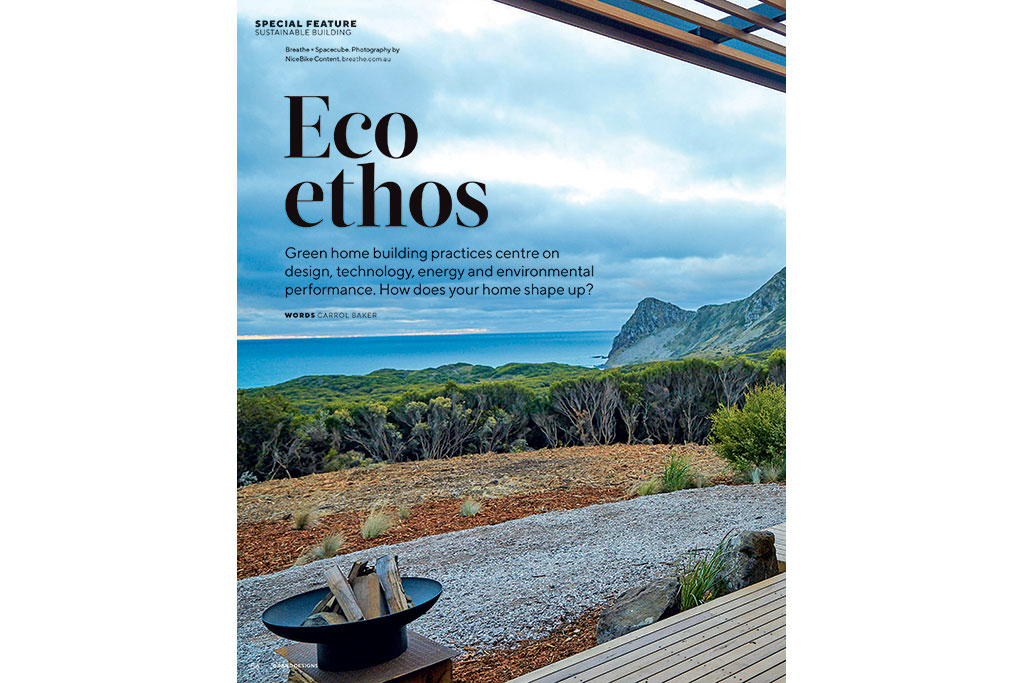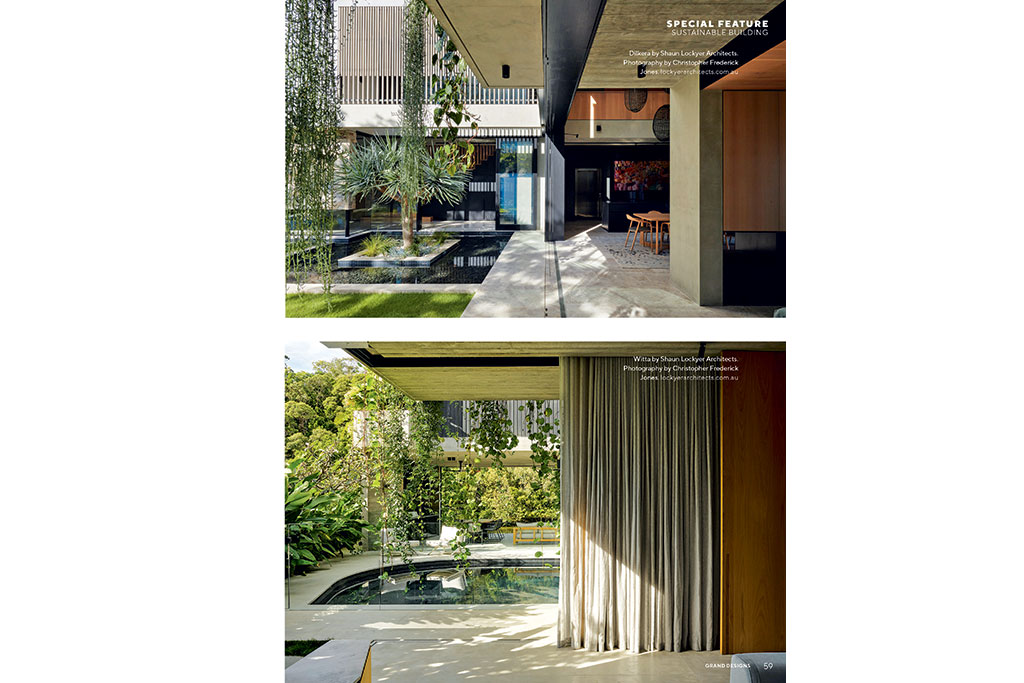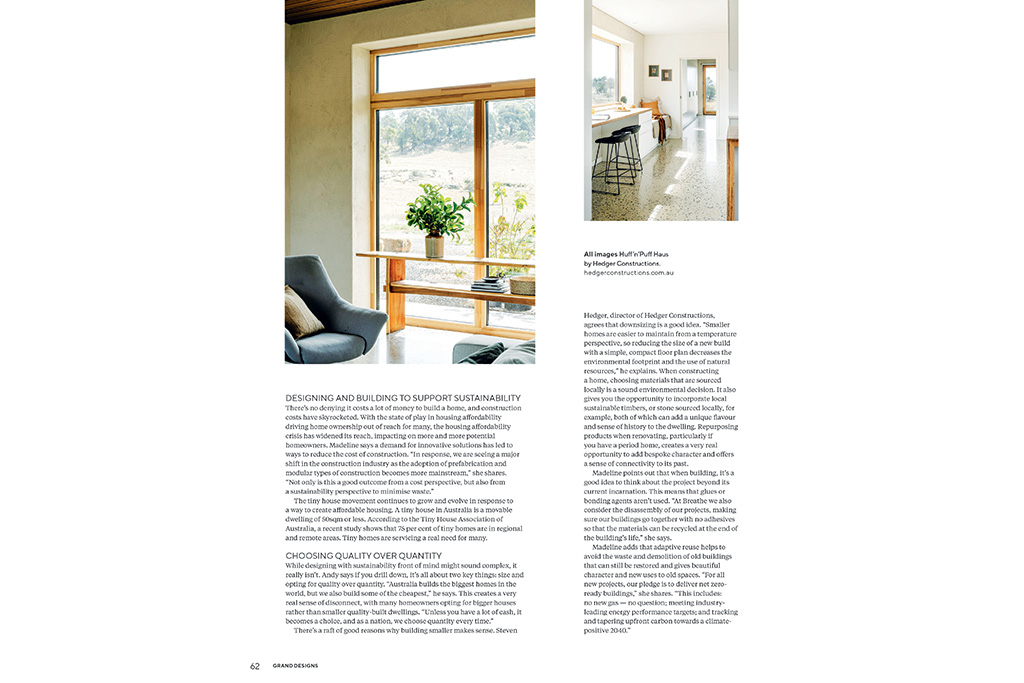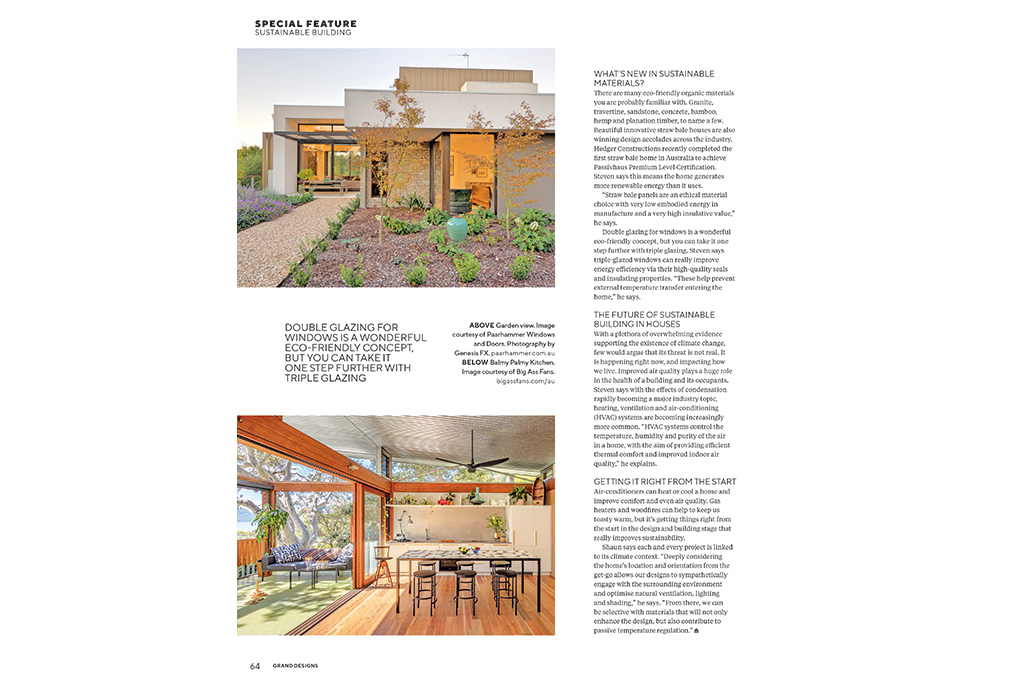Eco Ethos – Sustainability Feature
Grand Designs Australia Magazine
Green home building practices centre on design, technology, energy and environmental performance. How does your home shape up?
The call to arms about environmentally friendly building strategies has led to a profound shift in the way we do things. Building sustainability is more than just about taking measures to limit resources and energy — it’s linked to time-honoured craftsmanship and embraces living well, comfort and durability.
Sustainable homes are constructed with durable materials and building an eco-friendly home takes into consideration passive solar design. Each building site is unique, with its own microclimate. By assessing your site, your architect can best determine and implement a design that maximises the site’s orientation, minimises energy use, and creates a comfortable environment for those who live there.
SUSTAINABILITY REDEFINED
In broad strokes, what does sustainable building really mean? At Breathe Architecture, director of houses Madeline Sewall says as a practice they always return to their core belief — that the planet and humanity matter. “We use this as a lens for every decision we make and to us, sustainable buildings are about responding to this truth,” she notes.
Sustainability is all about balance — it’s a process that seeks to ensure that by incorporating certain philosophies, there are enough resources for all, now and into the future. Shaun Lockyer from Shaun Lockyer Architects says he remains a firm believer in the notion that to build sustainably, it’s essential to construct a dwelling that people will cherish. “It should be of durable quality and utilise timeless designs that people will love long beyond the original homeowner,” he says. “If people love it, they will protect it and ensure its longevity in the world.”
WHAT IS A BUILDING?
What type of construct is a building we live in? Holistically it’s somewhere to live, work and play. A place to come home to, an oasis that offers respite and calm. If we look at it from another perspective, a home is also an arrangement — a collection of spaces that work together. Andy Marlow, director at Envirotecture, says buildings are a holistic system. “However, they’re not generally approached that way by most people. The building is an ecosystem — you do one thing and it will impact on another,” he explains.
AN EVOLVING CONCEPT
Over the past decade or so, industry experts and other stakeholders are redefining what sustainability really means. For some people it’s been simply using more organic products, for others it’s buying local. With more knowledge and resources, there has been a united shift in consciousness. Shaun says sustainable features have gone from something that was “nice to have, to a necessity in all designs. This awareness and commitment have also led to tremendously innovative advancements across the industry, enabling the integration of smart building systems, renewable energy solutions, and the development of more sustainable materials.”
Do you know what embodied energy means? It’s the collective sum of all energy used to produce something, including mining, manufacture and transport. Embodied energy is a conversation, says Madeline, that more people are beginning to have. “We are seeing clients, consultants, suppliers and builders really interrogating and driving reductions in embodied carbon in buildings,” she comments. “We are seeing this across the industry, from construction materials to appliance manufacturers and furniture makers.”
DESIGNING AND BUILDING TO SUPPORT SUSTAINABILITY
There’s no denying it costs a lot of money to build a home, and construction costs have skyrocketed. With the state of play in housing affordability driving home ownership out of reach for many, the housing affordability crisis has widened its reach, impacting on more and more potential homeowners. Madeline says a demand for innovative solutions has led to ways to reduce the cost of construction. “In response, we are seeing a major shift in the construction industry as the adoption of prefabrication and modular types of construction becomes more mainstream,” she shares. “Not only is this a good outcome from a cost perspective, but also from a sustainability perspective to minimise waste.”
The tiny house movement continues to grow and evolve in response to a way to create affordable housing. A tiny house in Australia is a movable dwelling of 50sqm or less. According to the Tiny House Association of Australia, a recent study shows that 75 per cent of tiny homes are in regional and remote areas. Tiny homes are servicing a real need for many.
CHOOSING QUALITY OVER QUANTITY
While designing with sustainability front of mind might sound complex, it really isn’t. Andy says if you drill down, it’s all about two key things: size and opting for quality over quantity. “Australia builds the biggest homes in the world, but we also build some of the cheapest,” he says. This creates a very real sense of disconnect, with many homeowners opting for bigger houses rather than smaller quality-built dwellings. “Unless you have a lot of cash, it becomes a choice, and as a nation, we choose quantity every time.”
There’s a raft of good reasons why building smaller makes sense. Steven Hedger, director of Hedger Constructions, agrees that downsizing is a good idea. “Smaller homes are easier to maintain from a temperature perspective, so reducing the size of a new build with a simple, compact floor plan decreases the environmental footprint and the use of natural resources,” he explains. When constructing a home, choosing materials that are sourced locally is a sound environmental decision. It also gives you the opportunity to incorporate local sustainable timbers, or stone sourced locally, for example, both of which can add a unique flavour and sense of history to the dwelling. Repurposing products when renovating, particularly if you have a period home, creates a very real opportunity to add bespoke character and offers a sense of connectivity to its past.
Madeline points out that when building, it’s a good idea to think about the project beyond its current incarnation. This means that glues or bonding agents aren’t used. “At Breathe we also consider the disassembly of our projects, making sure our buildings go together with no adhesives so that the materials can be recycled at the end of the building’s life,” she says.
Madeline adds that adaptive reuse helps to avoid the waste and demolition of old buildings that can still be restored and gives beautiful character and new uses to old spaces. “For all new projects, our pledge is to deliver net zeroready buildings,” she shares. “This includes: no new gas — no question; meeting industry leading energy performance targets; and tracking and tapering upfront carbon towards a climate positive 2040.”
WHAT’S NEW IN SUSTAINABLE MATERIALS?
There are many eco-friendly organic materials you are probably familiar with. Granite, travertine, sandstone, concrete, bamboo, hemp and planation timber, to name a few. Beautiful innovative straw bale houses are also winning design accolades across the industry. Hedger Constructions recently completed the first straw bale home in Australia to achieve Passivhaus Premium Level Certification. Steven says this means the home generates more renewable energy than it uses.
“Straw bale panels are an ethical material choice with very low embodied energy in manufacture and a very high insulative value,” he says. Double glazing for windows is a wonderful eco-friendly concept, but you can take it one step further with triple glazing. Steven says triple-glazed windows can really improve energy efficiency via their high-quality seals and insulating properties. “These help prevent external temperature transfer entering the home,” he says.
THE FUTURE OF SUSTAINABLE BUILDING IN HOUSES
With a plethora of overwhelming evidence supporting the existence of climate change, few would argue that its threat is not real. It is happening right now, and impacting how we live. Improved air quality plays a huge role in the health of a building and its occupants. Steven says with the effects of condensation rapidly becoming a major industry topic, heating, ventilation and air-conditioning (HVAC) systems are becoming increasingly more common. “HVAC systems control the temperature, humidity and purity of the air in a home, with the aim of providing efficient thermal comfort and improved indoor air quality,” he explains.
GETTING IT RIGHT FROM THE START
Air-conditioners can heat or cool a home and improve comfort and even air quality. Gas heaters and woodfires can help to keep us toasty warm, but it’s getting things right from the start in the design and building stage that really improves sustainability.
Shaun says each and every project is linked to its climate context. “Deeply considering the home’s location and orientation from the get-go allows our designs to sympathetically engage with the surrounding environment and optimise natural ventilation, lighting and shading,” he says. “From there, we can be selective with materials that will not only enhance the design, but also contribute to passive temperature regulation.”







